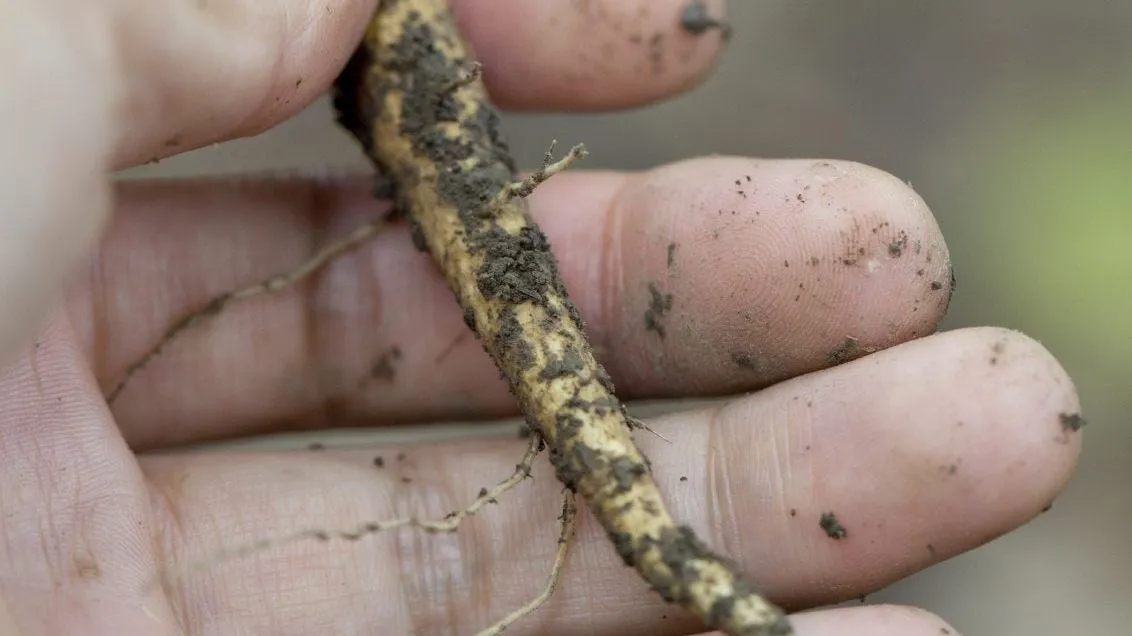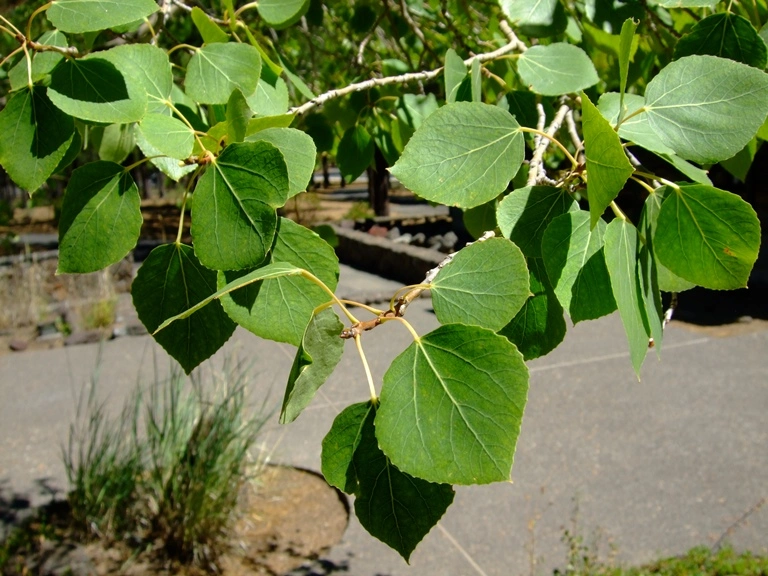The Quaking Aspen (Populus tremuloides) is a striking deciduous tree renowned for its distinctive trembling leaves, which flutter in even the lightest breeze. This tree’s unique movement is so remarkable that its botanical name, tremuloides, is derived from the Latin word “tremere,” meaning “to tremble.” Also known as the Aspen, this tree is easily recognized by its smooth white bark and round, fluttering leaves. Native to North America, Quaking Aspen thrives in cooler climates and is often found in forests, along riverbanks, and in the wild expanses of the American wilderness. Aspens are particularly beloved for their vibrant autumn transformation, where their leaves shift from a fresh spring green to a golden yellow, creating a breathtaking sight. While these trees grow tall and can reach up to 30 feet, they are a favorite among gardeners who appreciate their beauty and fast growth. However, it’s important to note that they tend to send up shoots from their roots, which can spread easily in the garden.
In this article, I will walk you through how to successfully propagate Quaking Aspen trees from root cuttings, share tips and tricks to ensure your success, and discuss some common challenges you might face along the way. Let’s dive in and learn how you can grow Quaking Aspen trees from root cuttings – these remarkable trees from scratch!
Read more: How to Grow Quaking Aspen Trees: A Comprehensive Guide
What Are Root Cuttings and Why Should You Use Them?

When it comes to propagating Quaking Aspen trees, root cuttings offer a fantastic way to grow these trees from scratch. Unlike growing from seeds, which can be a lengthy and unpredictable process, root cuttings provide a much more reliable method to replicate your favorite Aspen trees.
But what exactly are root cuttings? Essentially, you’re taking a piece of the tree’s root system and planting it to grow a new tree. This method is beneficial for gardeners who want to reproduce a specific variety or maintain the genetic characteristics of a tree. Root cuttings also offer the advantage of faster growth compared to seed propagation.
Benefits of Growing Quaking Aspen from Root Cuttings

Why should you choose root cuttings over other propagation methods? Here are just a few reasons why growing Quaking Aspen from root cuttings is a great idea:
-
Consistency: When you propagate Quaking Aspen from root cuttings, the new trees will be genetically identical to the parent tree. This means you won’t have to worry about variations in leaf shape, bark texture, or growth habits that can sometimes arise when growing from seeds.
-
Faster Growth: Root cuttings develop roots quickly, resulting in faster establishment of new trees. You’ll see your Aspen saplings growing strong and healthy in no time.
-
Simplicity: Root cuttings are an easy method for both seasoned gardeners and beginners. With just a few steps, you can grow your own Aspen trees from the comfort of your home or garden.
-
Cost-Effective: If you want to grow multiple Aspen trees, starting from root cuttings is much cheaper than buying a nursery-grown tree.
Choosing the Right Root for Cuttings
Not all roots are suitable for taking cuttings. When selecting roots for your Quaking Aspen propagation, make sure to pick strong, healthy roots from a mature tree. Here’s what you should look for:
-
Healthy, Thick Roots: Choose roots that are around 1/4 to 1/2 inch thick. These will have enough energy to grow new shoots.
-
Roots from the Outer Layer: Look for roots closer to the tree’s surface, as these are typically more active and likely to sprout new growth.
-
Avoid Damaged Roots: Don’t use roots that are diseased or damaged, as they are less likely to succeed.
How to Take Root Cuttings from Quaking Aspen Trees
Taking root cuttings from your Aspen trees is easier than you might think. Here’s a step-by-step guide to ensure you’re on the right track:
-
Find a Healthy Aspen Tree: Start by identifying a mature and healthy Quaking Aspen tree. This tree should be free from pests or diseases, ensuring that your cuttings will be healthy too.
-
Dig Up the Roots: Carefully dig up a section of the root system from the Aspen tree. Make sure to dig a few inches away from the base of the tree to avoid damaging the root system.
-
Select the Best Roots: Choose the thickest, healthiest roots for cutting. Cut the roots into 4-6 inch sections using a sharp, clean knife or pruning shears.
-
Prepare the Cuttings: Trim off any excess dirt from the root cuttings and make sure the ends are clean. You can dip the cut end into rooting hormone to promote faster root development, but this isn’t absolutely necessary. (Added tip: Rooting hormone isn’t a must, but it can significantly increase the chances of successful root formation.)
-
Plant the Cuttings: Plant the root cuttings in a container filled with well-draining soil or directly into the ground. Bury them about 2 inches deep, with the cut end facing down.
Planting Root Cuttings: In Ground or Pots?
Now that your root cuttings are ready, it’s time to decide where to plant them. There are two main options: planting directly in the ground or starting them in pots. Here’s what you need to know:
-
In the Ground: If you live in an area with suitable conditions for growing Aspen trees, you can plant your root cuttings directly in your garden. Choose a spot that gets full sun and has well-draining, loamy soil. Make sure the ground is prepared by loosening it with a shovel or garden fork.
-
In Pots: If you’re not ready to plant outdoors yet or live in a region with harsh winters, planting the cuttings in pots is a great option. Use a pot that is at least 6-8 inches deep and ensure it has drainage holes. Keep the pot in a sunny location, and water the cuttings regularly. (Added tip: Pots are especially useful for those living in areas with harsh winters or unpredictable weather.)
Caring for Your Quaking Aspen Cuttings
Once you’ve planted your Aspen cuttings, it’s time to care for them so they grow strong and healthy. Here’s what to keep in mind:
-
Watering: Keep the soil around your cuttings consistently moist, but not waterlogged. Aspen trees prefer well-draining soil, so make sure excess water can escape.
-
Sunlight: Aspen trees love the sun! Make sure your cuttings receive at least 6 hours of direct sunlight per day to help them thrive. (Added tip: For the best results, place your cuttings near a south-facing window or in a greenhouse.)
-
Fertilizing: Once your Aspen cuttings start to sprout, you can apply a balanced fertilizer to encourage healthy growth. Use a slow-release fertilizer to avoid burning the roots.
Common Challenges and How to Overcome Them
While propagating Quaking Aspen trees from root cuttings is a relatively easy process, there are a few challenges that gardeners may face. Here’s how to tackle them:
-
Root Rot: If your cuttings are too wet, they may develop root rot. Make sure your soil drains well and avoid overwatering.
-
Slow Growth: If your cuttings aren’t sprouting as quickly as you’d like, don’t worry. It can take a few weeks to a few months for the cuttings to establish roots and begin growing. Patience is key!
-
Pests: Keep an eye out for pests, such as aphids or beetles, which can harm your young Aspen trees. Treat them with organic pesticides if necessary.
Transplanting and Growing Your Aspen Trees to Maturity
Once your Quaking Aspen saplings are strong enough, you can transplant them into larger pots or directly into the ground. Ensure the soil is prepared for planting, and space each tree several feet apart to allow for future growth. Aspen trees can grow up to 30 feet tall in just a few years, so give them plenty of room to spread.
Frequently Asked Questions
-
How long does it take for Quaking Aspen root cuttings to grow into trees?
-
It can take several weeks for the cuttings to establish roots, and a few months for them to grow into small trees. Be patient, and your cuttings will eventually thrive.
-
-
Can I grow Quaking Aspen trees in pots instead of the ground?
-
Yes, you can! Aspen trees grow well in pots, especially if you live in an area with harsh winters. Just make sure the pots are large enough for the tree’s root system.
-
-
What are the best conditions for growing Aspen trees from root cuttings?
-
Aspen trees thrive in full sun, well-draining soil, and moderate moisture. They also prefer cool climates but can grow in a variety of conditions.
-
-
How do I know if my Aspen root cuttings are failing?
-
Signs of failure include root rot (blackened or mushy roots), dry or shriveled cuttings, and lack of new growth. Make sure you’re providing proper care to avoid these issues.
-
Conclusion
Growing Quaking Aspen trees from root cuttings is an incredibly rewarding process that can bring beautiful trees to your garden or yard. By following the simple steps outlined in this guide, you can successfully propagate Aspen trees and enjoy their unique beauty year after year. Whether you’re looking to expand your garden or create a natural, wooded space, growing Aspen trees from root cuttings is an excellent choice.
Are you ready to start your own Aspen grove? Grab your tools, find a healthy tree, and begin your journey to growing Quaking Aspen trees from root cuttings today!
